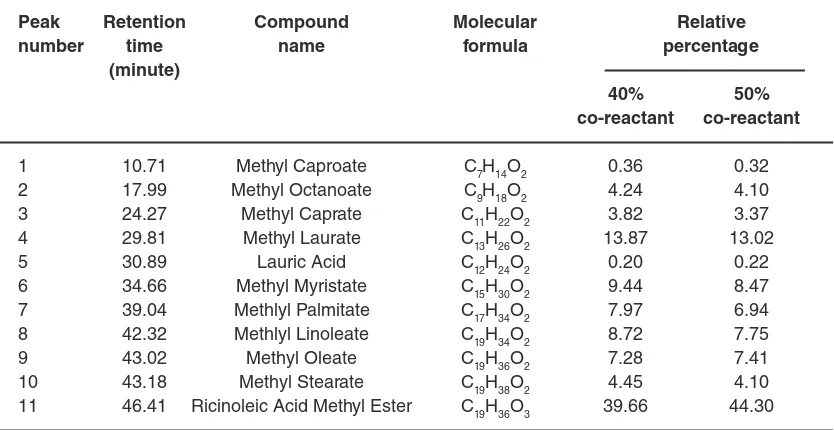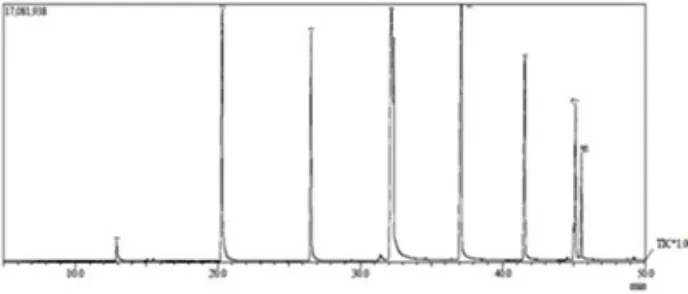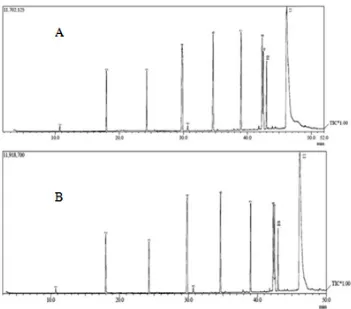www.orientjchem.org
An International Open Free Access, Peer Reviewed Research Journal CODEN: OJCHEG 2016, Vol. 32, No. (1):
Pg. 385-390
Transesterification of Castor oil using MgO/SiO
2Catalyst and Coconut oil as Co-reactant
KAMISAH D. PANDIANGAN
1,2, NOVESAR JAMARUN
1*,
SYUKRI ARIEF
1and WASINTON SIMANJUNTAK
21Department of Chemistry, Andalas University, Padang, Indonesia. 2Department of Chemistry, Lampung University, Bandar Lampung, Indonesia.
*Corresponding authors: E-mail: novesar62@yahoo.com http://dx.doi.org/10.13005/ojc/320143
(Received: January 04, 2015; Accepted: March 04, 2016)
ABSTRACT
This paper describes the transesterification of castor oil with the use of coconut oil as co-reactant and MgO/SiO2 as heterogeneous base catalyst. The catalyst was prepared from rice husk silica and magnesium nitrate by sol-gel method, with MgO load of 20% relative to silica, and then subjected to sintering treatment at 600 oC for 6 hours. A series of experiments was carried out, indicating that the use of coconut oil as co-reactant significantly promoted the conversion of castor oil into biodiesel.
Key words : castor, biodiesel, heterogeneous catalyst, co-reactant.
INTRODUCTION
Increased awareness of the need to reduce energy reliance on the non-renewable fossil fuels and various environmental impacts associated with their exploration, production and use, has driven global interest to continue development of renewable and environmentally-friendly biofuels. Various biofuels now exist, some of them have been industrially produced, while the others are still in development stage. One of biofuels that has been commercially available and applied to a certain extent is biodiesel.
At present, this biofuel has been used in several countries, by blending it with petrochemical diesel in certain ratio, without any need for modification of the engines1-2.
accounts for 75% of the total estimated production cost3. In addition, competition between edible oils for
energy and food industry should not be neglected. The ideal solution is utilization of non-edible oils, because they are relatively cheaper and can be obtained from various sources, one of them is castor (Ricinus communis) plant. Ricinus communis belongs to the Eurphorbiaceae family and also called castor beans. This plant is easily grown and resistant to drought4, can grow well in tropical and
subtropical regions across the world5-6. In addition,
the oil content of castor seeds may reach up to 33 - 56%7-9, suggesting that this non-edible crop is a
very promising raw material for cheaper biodiesel production.
One technical drawback in utilization of castor oil is the fact that this vegetable oil is more difficult to convert into biodiesel than the other oils, such as coconut oil. Many studies reported that compared to coconut oil, transesterification of castor oil requires higher temperature10 and higher methanol
to oil ratio11-12. In an attempt to circumvent these
problems, in this current study transesterification of castor oil was carried out using coconut oil as co-reactant. For this purpose, a series of experiments was carried out by addition of coconut oil with the quantities of 10, 20, 30, 40 and 50% (v/v) relative to the volume of castor oil used.
Traditionally, transesterification of vegetable oils is carried out using homogeneous catalysts, either strong acids such hydrochloric acid, sulfuric acid and nitric acid13-15 or strong bases mainly sodium
hydroxide and potassium hydroxide13,14. Apart
from their performance, homogeneous catalysts also suffers from several drawbacks, such as the formation of water and carboxylic acids, the difficulty to separate the catalyst from biodiesel, and corrosive nature of acid and base.
In order to overcome the problems associated with homogeneous catalysts, currently the use of heterogeneous catalysts is gaining popularity. The main advantage of heterogeneous catalyst is the fact that the catalyst and biodiesel can be separated simply by filtration, because they are in different phases, therefore, eliminates the need for washing the biodiesel with water. In addition, the opportunity for catalyst reuse is viable because
heterogeneous catalyst practically remains intact during the course of the reaction.
To take advantages of their beneficial characteristics, various types of heterogeneous catalysts have been developed and assessed, and of particular interest are base catalysts composed of the oxide of alkaline earth metals, primarily MgO and CaO supported on silica16-18. In addition to base
character, these catalyst systems were reported to posses high activity at relatively low temperature and under atmospheric pressure condition. In recognition of beneficial characteristics of heterogeneous catalyst, in this study, transesterification experiments were carried out using MgO/SiO2 catalysts with the MgO load of 20% (w/w). The catalyst was prepared from magnesium nitrate and rice husk silica using sol-gel technique. Utilization of rice husk silica was based on its availability and its solubility in alkaline solution, enabling the employment of sol-gel technique for preparation of the catalyst.
MATERIAL AND METHODS
The chemicals used in this study, magnesium nitrate, potassium hydroxide, and nitric acid, are reagent grade obtained from Aldrich. Rice husk used as a source of silica was obtained from local rice milling industry. Before use, the husk was sorted to obtain the husk with high silica content, by soaking it in distilled water overnight. Floating husk was discharged and sinking husk was collected and oven dried at 110 oC overnight. This part of the rice
husk was then used as source of silica. The main equipments used in this study is GC-MS QP2010 SE SHIMADZU for identification of transesterification product.
Extraction of silica
Extraction of silica from rice husk was carried out using alkalis extraction method as modified in previous studies19. A typical extracion
Table 1: The components of transesterification coconut oil
Peak Retention Relative Compound Molecular number time percentage name formula
(minute)
1 12.902 0.64 Methyl Caproate C7H14O2 2 20.294 13.10 Methyl Octanoate C9H18O2 3 26.591 11.08 Methyl Dekanoate C11H22O2 4 32.187 33.11 Methyl Laurate C13H26O2 5 37.131 19.13 Methyl Myristate C15H30O2 6 41.547 10.07 Methyl Palmitate C17H34O2 7 45.000 8.48 Methlyl Linoleate C19H34O2 8 45.550 4.39 Methlyl Stearate C19H38O2
Table 2: The components of biodiesel obtained from castor oil using coconut oil as co-reactant
Peak Retention Compound Molecular Relative number time name formula percentage
(minute)
40% 50% co-reactant co-reactant
1 10.71 Methyl Caproate C7H14O2 0.36 0.32
2 17.99 Methyl Octanoate C9H18O2 4.24 4.10
3 24.27 Methyl Caprate C11H22O2 3.82 3.37
4 29.81 Methyl Laurate C13H26O2 13.87 13.02
5 30.89 Lauric Acid C12H24O2 0.20 0.22
6 34.66 Methyl Myristate C15H30O2 9.44 8.47
7 39.04 Methlyl Palmitate C17H34O2 7.97 6.94
8 42.32 Methlyl Linoleate C19H34O2 8.72 7.75
9 43.02 Methyl Oleate C19H36O2 7.28 7.41
10 43.18 Methyl Stearate C19H38O2 4.45 4.10
11 46.41 Ricinoleic Acid Methyl Ester C19H36O3 39.66 44.30 the sol into gel. The gel was rinsed with hot distilled
water several times to expell the excess of acid, and subsequently oven dried at 110 oC for 8 hours
to produce dry silica. For preparation of catalysts, 20 grams of dry silica was redissolved in 100 mL of 1.5 wt% NaOH solution.
Preparation of catalyst
For preparation of catalysts, a silica solution prepared as described above was transferred into an Erlenmeyer flasks placed in ultrasound agitator. A specified volume (50 mL) of 1.0 N Mg(NO3)2 solution, to obtain the catalyst with the MgO content of 20 wt%, was slowly added into the sol under
ultrasound agitation, followed by drop wise addition of 10% HNO3 solution until the sol was completely transformed into gel. The gel was aged for three days and subsequently oven dried at 110 oC for 8
hours. Dry catalysts were ground into powder, and then subjected to sintering treatment at 600 oC for
six hours.
Transesterification experiment
Fig. 1: The GC chromatogram of biodiesel derived from coconut oil
The transesterification unit was immersed in a water bath situated on top of a magnetic stirrer with heating plate. Transesterification reaction was commenced at 70 oC for two hours, and then the sample was cooled
to room temperature and then filtered into separatory funnel, to separate the catalyst. The sample in the separatory funnel was allowed to settle for six hours to separate the mixture into two layers, and the upper layer which is the biodiesel was collected. The excess of methanol was removed by evaporation and the volume of biodiesel was measured for percent conversion calculation.
To study the role of co-reactant (coconut oil) in promoting transesterification of castor oil, five experiments were carried out, in which an aliquot of 50 mL of castor oil was added with 5.0; 10.0; 15.0; 20.0; and 25.0 mL of coconut oil, respectively. Transesterification of castor oil without co-reactant was also conducted as a control.
Analysis of transesterification products using GC-MS
I d e n t i f i c a t i o n o f FA M E s i n t h e transesterification product was conducted with the aid of gas chromathography-mass spectroscopy (GC-MS) technique. The analysis was carried out on GCMS-QP2010 SE SHIMADZU, equipped with 30 m long and 0.32 mm internal diameter HP SMS 30 m column. The instrument was operated in the EI mode at 70 EV using helium as carrier gas and nitrogen as make up gas to obtain the total flow rate of 60 mL/min. Tentative identification of the components in the sample was done by comparing the mass
spectra of the component to those published in the MS Library System NIST62, Wiley 7, database. The relative amount of each component was estimated by dividing the peak area of the component with the total peak area of all components identified.
RESULTS AND DISCUSSION
The first experiment was conducted to assess the activity of the catalyst, using coconut oil as single reactant. The GC chromatogram of the sample obtained is presented in Figure 1, and the identified components were listed in Table 1.
As can be seen in the chromatogram (Figure 1), the components display very good peak shapes and they are well separated from each other. A total of 8 peaks are observed in the chromatogram. The compounds identified in the chromatogram, presented in Table 1, composed of a series of methyl esters, which correspond to fatty acids commonly found in coconut oil. These methyl esters confirmed that the catalyst worked for different kinds of fatty acids as expected. The data also display that methyl laurate is the most prominent component of the sample, which is in accordance with the existence of lauric acid as the most abundant component of coconut oil, commonly reported20-21.
The rest of the experimental conditions were kept the same for all the experiments. The results obtained indicated that no biodiesel was produced from the transesterification of castor oil without co-reactant. The experiments with the use of co-reactant demonstrated that significant conversion of castor oil into biodiesel was achieved with the use of 40 and 50% co-reactant, as evidently displayed by the GC chromatograms presented in Figure 2, and the components of the samples presented in Table 2.
As can be seen in Figure 2, both chromatograms display the existence of 11 peaks, at practically the same retention times, supporting the existence of the same compounds in both of the samples. The presence of ricinoleic acid methyl ester in the products (Table 2) indicates that conversion of castor oil into biodiesel has
been achieved, since ricinoleic acid is the specific component of castor oil4,7. In addition, no significant
difference between the relative percentages of ricinoleic acid methyl ester and methlyl linoleate in both samples, suggesting that the use of 40% co-reactant is sufficient to enhance the conversion of castor oil into biodiesel.
CONCLUSION
The results obtained demonstrate that the use of coconut oil as co-reactant significantly promotes transesterification reaction to convert castor oil into biodiesel. The most significant improvement with the use of co-reactant is reduction of reaction time to two hours, which is much shorter than the reaction time commonly applied for transesterification of castor oil reported in literatures.
1. Lee, A. F.; Bennet, J. A.; Manayil, J. C.; Wilson, K. Chem. Soc. Rev. 2014, 43, 7887-7916 2. Gorji, A.; Ghanei, R. J. Bio & Env. Sci. 2014,
5 (4), 48-59
3. Atabani, A. E.; Silitonga, A. S.; Badruddin, I. A.; Mahlia, T. M. I.; Masjuki, H. H.; Mekhilef,
S. Renewable and Sustainable Energy Rev.
2012, 16, 2070–2093
4. Gui, M. M.; Lee, K. T; Bhatia, S. Energy. 2008, 33, 1646– 1653
5. Iliæ, I. B. B.; Stamenkoviæ, O. S.; Veljkoviæ, V. B. Renewable and Sustainable Energy Rev.
2012, 16, 3621– 3647
6. Shrirame, H. Y.; Panwar, N. L.; Bamniya, B. R. Low Carbon Economy. 2011, 2, 1-6 7. Okullo, A.; Temu, A. K.; Ogwok, P.; Ntalikwa,
J.W. International Journal of Renewable Energy Research. 2012, 2 (1), 379 – 384 8. Ogunniyi, D.S. Bioresour. Technol. 2006, 97,
1086–1091
9. Akpan, U. G.; Jimoh, A.; Mohammed, A. D. Leonardo Journal of Sciences. 2006, 8, 43-52
10. Almeida, R. M. D.; Noda, L. K.; Gonc¸alves, N. S.; Meneghetti, S. M. P.; Meneghetti, M. R. Appl. Catal., A 2008, 347, 100–105
11. Silva, N. D. L. D.; Batistella, C. B.; Filho, R. M.; Maciel, M. R. W. Energy Fuels. 2009, 23 (11),
5636–5642
12. Yuan, H.; Yang, B. L.; Zhu, G. L. Energy Fuels.
2009, 23 (1), 548–552
13. Murrieta, C. M.; Hess, B. W.; Rule, D. C. Meat Science. 2003, 65, 523–529
14. Jain, S.; Sharma, M. P.: Rajvanshi, S. Fuel Process. Technol. 2011, 92, 32–38
15. Goff, M. J.; Bauer, N. S.; Lopes, S.; Sutterlin, W. R.; Suppes, G. J. JAOCS. 2004, 81 (4), 415-420
16. Gulkova, D.; S¡olcova´, O.; Zdraz¡il, M. Microporous Mesoporous Mater. 2004, 76, 137–149
17. Moradi, G.; Mohadesi, M.; Hojabri, Z. Reac. Kinet. Mech. Cat. 2014, 113 (1), 169-186 18. Albuquerque, M. C. G.; Urbistondo, I. J.;
Gonza´lez, J. S.; Robles, J. M. M.; Tost, R. M.; Castello´n, E. R.; Lo´pez, A. J.; Azevedo, D. C. S.; Cavalcante Jr, C. L.; Torres, P. M. Appl. Catal., A. 2008, 334, 35–43
19. Pandiangan, K. D.; Simanjuntak, W. Indo. J. Chem.2013,13 (1), 47 – 52
20. Benjapornkulaphong, S.; Ngamcharussrivichai, C. ; Bunyakiat, K. Chem. Eng. J. 2009, 145, 468–474
21. Nakpong, P.; Wootthikanokkhan, S. Renewable Energy, 2010, 35, 1682–1687


